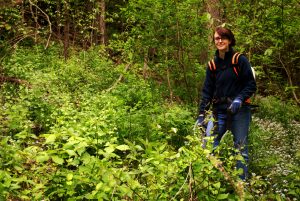By Rob Stroh
Edited by Andy West
I read an opinion article in the Southern Illinoisan newspaper a few months ago, and it has bugged me ever since so here is my response. It was an article about how we shouldn’t bother treating invasive species, because “Almost all species, at some point, arrived from somewhere else.” He was proclaiming that the government should not be spending money on a problem that will “fix itself”. His main argument was that invasive species are just “relative newcomers” and if they would have arrived 100,000 years ago they would have naturalized by now. I agree with him. It is true exotic species have not changed, but what has is the number of exotics arriving and the ecosystems that are here to greet them.
In order to explain let’s put ourselves in the role an exotic species that arrived 100,000 years ago. We would first have to make the long trip from Europe to North America before humans traveled from continent to continent. If we made it a crossed the vast ocean, a 3,475-mile journey, we would have accomplished an extraordinary feat! However, when we arrived it was to a land that hadn’t been affected by humans. Ecosystems functioned the way they should and all niches were filled. This would make it difficult for us to find the resources we need to survive. Compounding the problem, if the climate wasn’t right for all of us to flourish, many of us would die. If a strong few had the right traits to necessary to survive and we were lucky enough to find a niche that could be exploited, we would be able to establish a population. This would have been very unlikely occurrence.

Eileen Eck treating a garlic mustard infestation at LaRue-Pine Hills in southwest Illinois
Why wouldn’t it be the same for exotic species today if we give them enough time? There are some differences in this story told above and the story told today. The first is the ease with which species are now transported. Everyday exotic species make that 3,475-mile journey by catching rides in the cargo and ballast water of ships and more are brought over as garden plants, or for erosion control. Not all of these exotic plant become invasive. However, it only takes one species to severely alter a native ecosystem. The second difference is the shape of our current environment. At the time of European settlement approximately 307,000 acres of wetlands, 19.5 million acres of prairie and 14.7 million acres of forest existed here. To date we have lost 90% of the wetlands, 99.9% of prairie communities, and 36% of our forests. (IDNR, 1996) Healthy, functional ecosystems have been converted to farms and urban areas. I’m not knocking agriculture and cities. Civilization as we know it wouldn’t exist if it wasn’t for our ability to feed ourselves and live together. However, we must acknowledge that we have changed the dynamics of our ecosystems. Ecosystems affected by humans are weaker and dysfunctional. Gaps left in destabilized ecosystems are vulnerable to colonization by invasive species. In my opinion, since we are responsible for making the mess, we are responsible for cleaning it up as well!
Invasive species are vastly different than our native plants and animals. By taking advantage of our weakened ecosystems, they multiply uncontrollably, and rob resources to form massive monocultures that drastically change the dynamics of our native ecosystems. So something needs to be done. We can’t sit back and witness the collapse of our natural areas. Mistakes and accidents happen, but we are still responsible for the mistakes we make.
For more information on the species of plants are currently invading our state. Visit this site for a full list of the invasive species in Illinois http://www.invasive.org/illinois/speciesofconcern.html
Illinois Department of Natural Resources. 1996. Illinois Land Cover, An Atlas. Critical Trends Assessment Project – Phase 2. Illinois Department of Natural Resources, Springfield, Illinois.

Leave a Reply